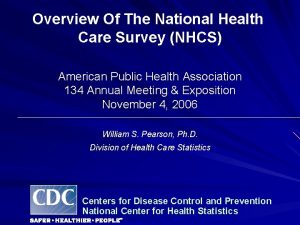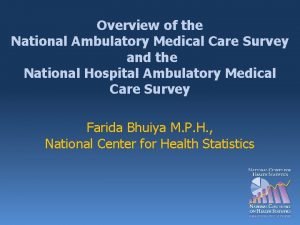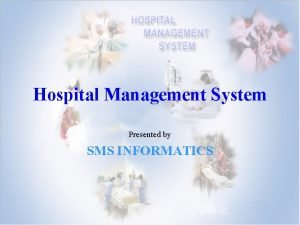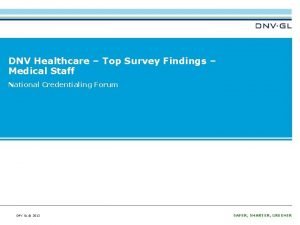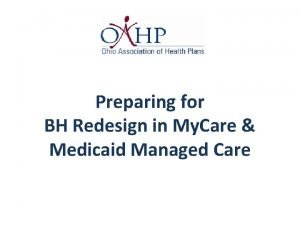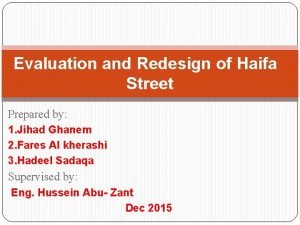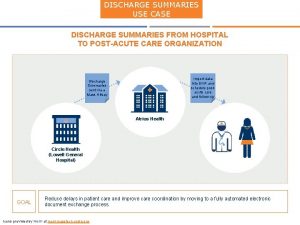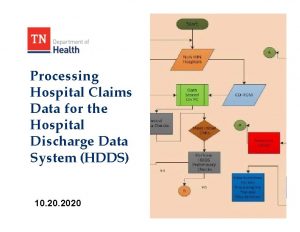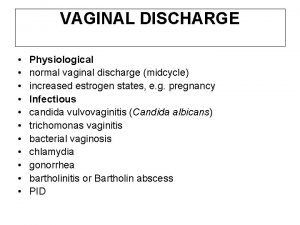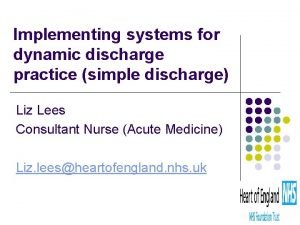Redesign of the National Hospital Discharge Survey Jane













- Slides: 13

Redesign of the National Hospital Discharge Survey Jane Sisk and Robert Pokras Board of Scientific Counselors May 5, 2006 Division of Health Care Statistics National Center for Health Statistics Centers for Disease Control and Prevention

Overview • Provider and discharge rather than person based • National probability sample of short-stay non. Federal hospitals • Annual survey since 1965 • 3 -stage design primary sampling unit (PSU) → facility → discharge • About 500 hospitals, 370 K discharges per year • About 92% response rate, in-scope hospitals • About half from automated systems, half from manual abstraction in hospital

Data Collected: UB 92 - Hospitals Bed size Sources of revenue Ownership Region - Patients Demographics Diagnoses Insurance status Discharge status ZIP code - Clinical management Days of care Source of admission Type of Admission Procedures/surgery Disposition DRG

Used for Policy and Research • Assessment of quality/safety and disparities • • • Epidemiology of specific medical conditions Management of specific medical conditions Diffusion of health-care technologies Effects of policy changes Monitoring changes over time

Hospitalizations by Age, U. S. , 1970 -2004

Coronary Artery Bypass Graft (CABG) and Percutaneous Coronary Intervention (PCI), 1980 -2002 Rate per 10, 000 population PCI CABG 1980 1985 SOURCE: Hospital Discharge Survey 1990 1995 2000

Context of Redesign • Data elements limited to UB 92 (UB 04) • Meeting needs for future policy and research? • Comparative advantage given other data sources, e. g. , AHRQ statewide discharges from 41 states?

Redesign Process So Far To take a fresh look at future policy and research issues and associated data needs and gaps • Interviews with key stakeholders and users to identify future issues and needs - Provider associations - Providers - Government agencies - Consumer groups - Researchers - Data collectors • Scan of other surveys and data sources • Working group meeting in March

Working Group Robert Brook RAND David Carlisle Calif. Off. of Statewide Health Planning and Development Carolyn Clancy AHRQ Paul Ginsberg Center for Studying Health System Change Mark Hornbrook Kaiser-Permanente Portland Center for Health Research Chip Kahn Fed. of Am. Hospitals Beth Mc. Glynn RAND Karen Milgate MEDPAC John Rolph Univ. of So. Calif. Jim Scanlon ASPE Julie Sochalski Univ. of Penn.

Ratings of Priority Issues • Cost of care/use of resources including efficiency/waste • Quality of care/safety including disparities • Care delivered in the hospital • Surveillance and public health including surge capacity • Globalization including outsourcing

Highest Rated Options for Redesign • • • Coordinate with AHRQ data collection (HCUP) Add clinical depth, e. g. , medications, tests Add resource use/cost/billings/payments Improve patient demographics, e. g. , ethnicity Link to health-related outcomes, e. g. , death index

Other Options • Track disease-specific care • Supplement AHRQ's MEPS with medical record data on inpatients • Add short-stay admissions and observation status • Track encounters throughout the hospital • Follow patient over time – pre and post hospital care – episode of care – patient after discharge • Keep status quo • Eliminate NHDS

Next Steps • Summer 2006: – Final conceptual framework – Selection of strategy and data elements • 2006 -2007: Feasibility test in 9 hospitals • 2008: Field test • 2010: New survey fielded
 National hospital care survey
National hospital care survey National hospital ambulatory medical care survey
National hospital ambulatory medical care survey Partial discharge survey
Partial discharge survey Types of patient admission
Types of patient admission Appeal hospital discharge
Appeal hospital discharge Discharge certificate from hospital
Discharge certificate from hospital Acls abcd
Acls abcd Dnv hospital survey
Dnv hospital survey Tdes school
Tdes school Getting organizational redesign right
Getting organizational redesign right Bh redesign
Bh redesign Job redesign meaning
Job redesign meaning Procurement process redesign
Procurement process redesign Redesign haifa
Redesign haifa
